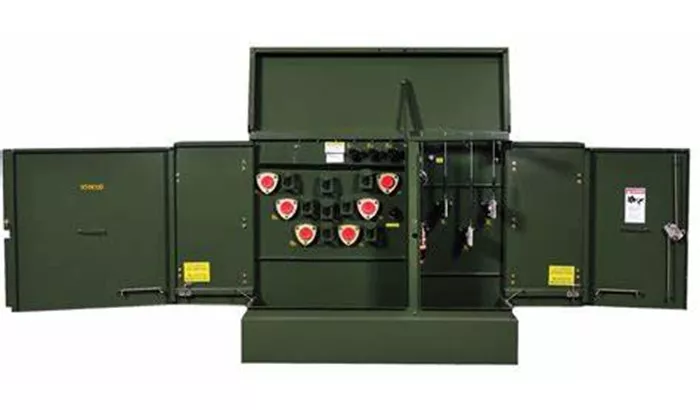Padmount transformers are essential components in modern electrical power distribution systems. They are designed to be installed at ground level on a concrete pad, providing a safe and efficient means of stepping down high-voltage electricity to levels suitable for residential, commercial, and industrial use. These transformers are enclosed in tamper-resistant, weatherproof metal cabinets, making them ideal for urban and suburban environments where appearance and safety are significant considerations.
Definition of a Padmount Transformer
A padmount transformer is a type of distribution transformer that is installed on a concrete pad at ground level. It is enclosed in a locked metal cabinet, which provides protection against environmental factors and unauthorized access. The transformer steps down high-voltage electricity from the power grid to a lower voltage suitable for local distribution.
Construction and Design
Padmount transformers are constructed with several key components:
Core: The magnetic core, typically made of laminated silicon steel, facilitates the transfer of electrical energy between the primary and secondary windings.
Windings: These are coils of insulated copper or aluminum wire. The primary winding receives the high-voltage input, and the secondary winding provides the stepped-down voltage output.
Insulating Oil: Many padmount transformers are oil-filled, using a dielectric fluid to insulate and cool the internal components. Some modern designs use solid insulation or eco-friendly fluids like ester oils.
Bushings and Terminals: These components allow for the connection of high and low-voltage cables to the transformer.
Protection Devices: Fuses, circuit breakers, and surge arresters are often included to protect the transformer and the connected circuits from faults and surges.
Function and Operation
The primary function of a padmount transformer is to convert high-voltage electricity from the distribution lines to a lower voltage suitable for local use. The transformer operates on the principle of electromagnetic induction, where a change in the magnetic field within the core induces a voltage in the secondary winding proportional to the turns ratio of the windings.
For example, if the primary winding has 100 turns and the secondary winding has 10 turns, the voltage will be stepped down by a factor of 10. This means a 12,000-volt input would be reduced to 1,200 volts on the output side, making it safe for residential or commercial use.
Types of Padmount Transformers
Single-Phase Padmount Transformers
Single-phase padmount transformers are commonly used in residential areas to supply power to homes and small commercial buildings. They are designed to be reliable and can handle lower power ratings, often up to 5,000 kVA.
Three-Phase Padmount Transformers
Three-phase padmount transformers are typically used in industrial and larger commercial settings where higher power loads are required. These transformers can handle a higher primary voltage and distribute power efficiently to multiple locations within a network.
Applications of Padmount Transformers
Padmount transformers are widely used in various settings due to their versatility and efficiency. Some common applications include:
Residential Areas
They are often seen in suburban neighborhoods, where they provide power to homes from underground distribution lines. This underground setup improves aesthetic appeal and enhances reliability by reducing exposure to weather-related damages.
Commercial Complexes
Shopping centers, office buildings, and other commercial establishments rely on padmount transformers to supply the necessary electrical power for lighting, HVAC systems, and other electrical equipment.
Industrial Sites
Manufacturing plants and other industrial facilities use these transformers to step down voltage for heavy machinery and equipment, ensuring safe and efficient operation.
Renewable Energy Projects
Padmount transformers are also crucial in renewable energy applications, such as wind and solar farms, where they step down the voltage generated by renewable sources for grid integration.
Key Features of Padmount Transformers
High Performance
Padmount transformers utilize 10/11-type or amorphous alloy cores for low loss, low noise, and high short-circuit resistance.
Functionality
These transformers are capable of load current interruption, full-range current protection, flexible high-voltage input, phase-loss protection, and basic substation functionality.
Space-Saving & Cost-Effective
Padmount transformers have a compact size, requiring minimal installation effort and rapid deployment. Their design saves space and reduces costs compared to traditional substations.
Safety
Fully enclosed designs with insulated elbow cable plugs ensure personnel safety and eliminate exposed conductive parts.
Why Choose Padmount Transformers Over Other Types?
Padmount transformers offer several advantages compared to other types of transformers, such as pole-mounted transformers:
Space Constraints: Padmount transformers are ideal for locations with limited space, as their compact design allows them to be installed in confined areas.
Aesthetics: Their low-profile design and weatherproof enclosures help them blend into the surrounding environment, making them less visually intrusive.
Safety and Security: The tamper-resistant enclosures provide an added layer of security, protecting the transformer from vandalism and unauthorized access.
Noise Reduction: Padmount transformers are generally quieter, making them suitable for noise-sensitive areas.
Flood Resistance: In flood-prone areas, their elevated position on a concrete pad helps protect the transformer from flood-related damage.
Conclusion
Padmount transformers are crucial in modern power distribution systems, providing a safe, efficient, and aesthetically pleasing solution for stepping down high-voltage electricity to usable levels. Their unique advantages make them a preferred choice for many applications, ensuring reliable power distribution while addressing space constraints, safety concerns, and noise reduction.
Related Topics:

